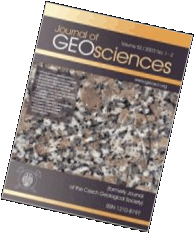Original Paper
Morphological and compositional evolution of tourmaline from nodular granite at Lavičky near Velké Meziříčí, Moldanubicum, Czech Republic
Journal of the Czech Geological Society, volume 49 (2004), issue 1-2, 81 - 90
Several distinct paragenetic, morphological and compositional types of tourmaline were described in the Lavičky nodular granite and associated rocks exposed at the NE margin of the Třebíč durbachite massif. Abundant tourmaline I (schorl, oxy-schorl) occurs in quartz-tourmaline nodules and vein-like aggregates; tourmaline II (schorl, oxy-schorl, fluor-sehorl) forms columnar subhedral crystals and their aggregates in coarse-grained pegmatite; rare, dark grey to greyish brown, fibrous tourmaline III (oxy-dravite, fluor-dravite) occurs in late quartz veins. Tourmaline I and II contain small inclusions and veinlets of dravite tourmaline (dravite, fluor-dravite, oxy-dravite) with very complicated textural relations. They are typical for the Lavičky and were only sporadically found in other localities of nodular granites.
Derivation of exchange vectors was complicated. Tourmaline I exhibits combination of the exchange vectors (AlO) [R2+(OH)]-1, (×Al2O) [NaR2+2(OH)]-1 and Mg Fe-1. Tourmaline II seems to be characterized by the vector (×Al2O) [NaR2+2(OH)]-1. Tourmaline III shows significant participation of the vector (AlO) [R2+(OH)]-1 besides the vectors Mg Fe-1 and combination of the vectors (CaO) [Na(OH)]-1 and CaR2+O) [×Al(OH)]-1. Dravite inclusions and veinlets exhibit the dominant exchange vectors (CaR2+) (NaAl)-1 and Mg Fe-1. All types of tourmaline exhibit high participation of the vector F (OH)-1. Tourmaline I and II from nodular granite and pegmatite exhibit very similar chemical compositions and substitution mechanisms relative to those from the other nodular tourmaline granites and primitive granitic pegmatites in the Moldanubicum.
Webdesign inspired by aTeo. Hosted at the server of the Institute of Petrology and Structural Geology, Charles University, Prague.
ISSN: 1803-1943 (online), 1802-6222 (print)
email: jgeosci(at)jgeosci.org


IF (WoS, 2024): 1.3
5 YEAR IF (WoS, 2024): 1.4
Policy: Open Access
ISSN: 1802-6222
E-ISSN: 1803-1943
 Export to Mendeley
Export to Mendeley